The battle between a diamond and moissanite over the central place in an engagement ring has become fierce in recent years. One camp claims nothing is better than a diamond for any type of high-end symbolic jewelry. The representatives of another party enjoy their moissanite engagement rings and see how the quality meets the price in them.
Who is right in this dispute? Read our guide and see who has more advantages in the Diamonds Against Moissanite race!
For people who never tried choosing between various precious gems for engagement jewelry, the diamonds against moissanite confrontation may sound weird. But when it comes to the real value-for-money dilemma, couples become picky and consider these gemstones more seriously. For them, the confusion appears almost inevitably.
However, most buyers don’t see differences between a diamond and moissanite. These gems reveal completely different advantages if only you compare them in a large size. But once noticed, these variances cause the agony of choosing.
We’re here to assist you in setting the exact value of a diamond and moissanite. For this, we’ve designed this guide as an imaginary Diamonds against Moissanite race. Each criterion discussed (including color, price, and brilliance, among other parameters) adds points to either classic moissanite or a round diamond. As a result, you’ll see the whole thing of how many advantages each jewel possesses and how to choose one between them.
In the end, we leave picking the winner in the Diamonds vs. Moissanite battle is to you. All we do here is guiding you through the peculiarities of both precious stones.
Before the battle starts, let’s present our rivals in detail. And the first gemstone we’ll review is moissanite.
Some people romantically call moissanite “Space Diamond” or “Stardust.” Though sounding pretty pathetic, this labeling has some rational grounds. Indeed, moissanite has a cosmic origin: the gemstone is typically found in the craters created by a fallen meteorite. Because of its unique chemical composition, it’s impossible to confuse moissanite with any other stone. Precisely, this jewel is made from a rare combination of silicon carbide.
Another interesting fact about moissanite is its name. Henri Moissan was the first person to find it — that’s why the stone got his name. His remarkable discovery happened in 1893 during the expedition to a meteor crater in Arizona. It took nine years to understand that the crystals found are not diamonds but moissanite samples.
Before we proceed to diamonds, there’s one more important thing you should know about this rival. Natural moissanite is a rare find — simply because not so many meteors land on the Earth. These days, its deposits are found in two places on our planet only: one is in Wyoming, and another one is in central Russia. Due to this scarcity, we currently deal with lab-created moissanite jewelry only. This fact mostly affects the set of moissanite advantages and disadvantages.
For this rivalry, we’ve picked the most common moissanite from its pioneer producer, Charles & Colvard. It has the title Forever Classic.
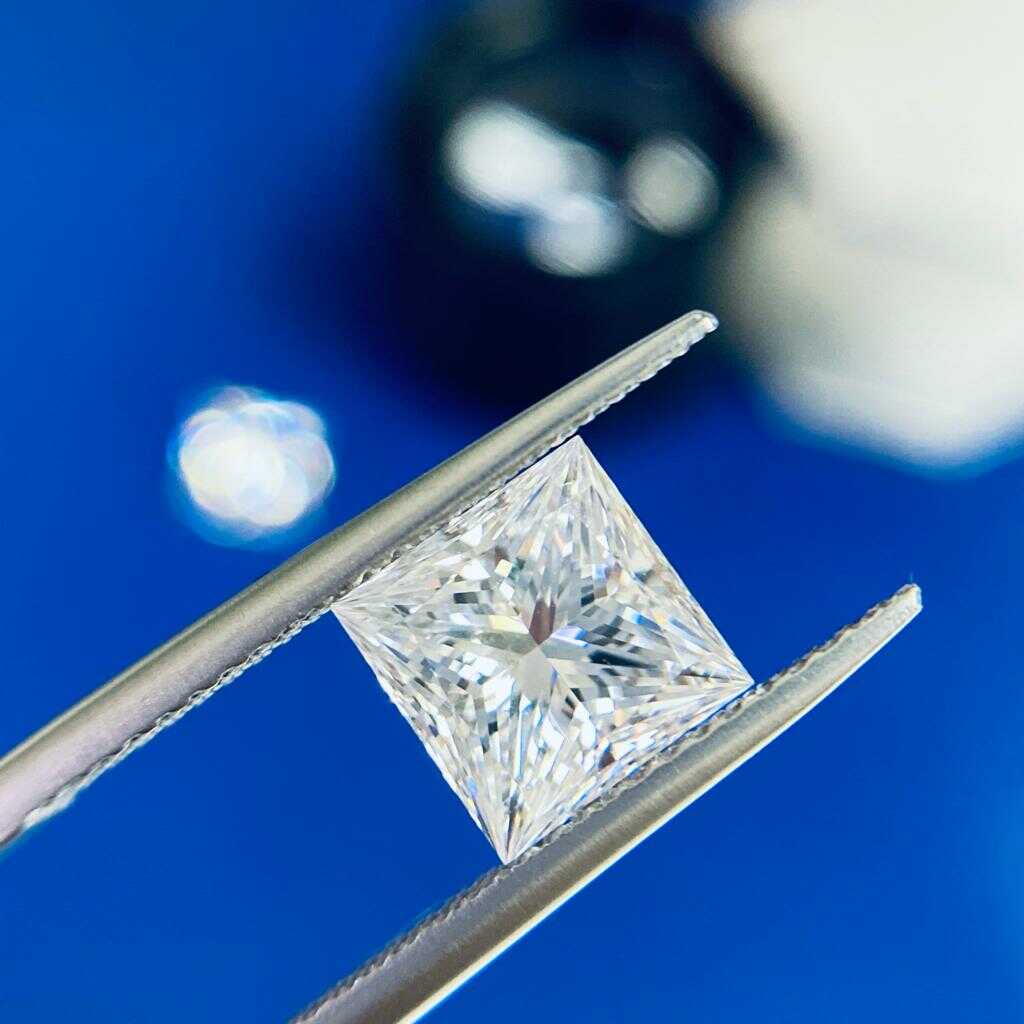
There’s no need to create a long presentation speech for diamonds. We all know they are girls’ best friends and the symbol of eternal love and serious intentions about marriage. And of course, everybody knows that diamonds are forever.
Indeed, the formation of this precious stone is close to the eternity of time. To be more accurate, it takes hundreds of years so that carbon under high temperature and pressure turns into a diamond. In contrast to the space origin of moissanite, this jewel is mined from Earth and then carefully cut to achieve perfection. To be considered a good deal, diamonds must pass the laboratory exams with high grades in several parameters — especially in the dimensions of clarity, cut, and color. These requirements leave only the best samples in the diamond trade. Also, they increase the value of these gemstones once they become eligible for sale. In this sense, a perfect diamond is as rare as natural moissanite.
Besides, not only natural diamonds are on the jewelry market these days. Recently, there appeared rings and earrings featuring lab-grown diamonds. These precious stones pass the same formation stages — but in a controlled laboratory environment and much faster. However, the popularity and quality of these jewels are still far from becoming the real alternative to natural diamonds.
Therefore, we disregard lab-grown diamonds (because they are not the precious stones you’ll compare moissanite with) and pick a natural round diamond for this rivalry. Moreover, we consider only a GIA-certified diamond to eliminate the risk of inaccurate grading and pick the sample with real value-for-money.
So, let’s start the Diamonds Against Moissanite race to check whether diamonds cost their money!
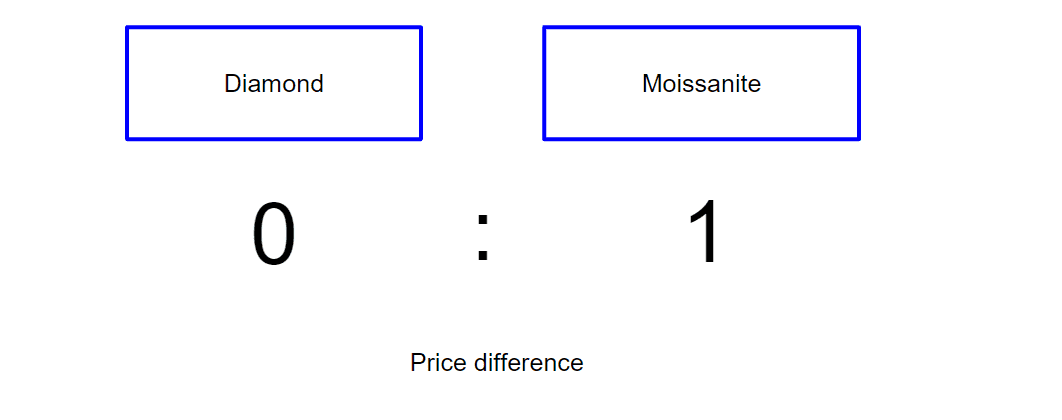
In the Diamonds vs. Moissanite battle, the most powerful and obvious argument in favor of moissanite is its highly attractive price. Imagine: you can buy moissanite twice bigger than a diamond for the same amount of money!
But what’s the catch? Follow reading to understand how value and quality affect the cost difference between moissanite and diamonds.
But don’t just take us at our word — we’ll give you real numbers for comparing the gemstones according to price criterion. Here’s the approximate diamond cost range:
And what if you choose Forever Classic moissanite? The carat-weight system doesn’t work with it (to get the reason, jump to the round “Weight” in this guide), but you can compare these two gemstones by their size. By doing this, you’ll realize it’s possible to get moissanite of a 1-carat diamond size for $1,000 (or less!). And if you have $5,000, you can spend this sum for moissanite that looks twice bigger than a 1.3-carat diamond! The truth is, no matter which option you choose, this gemstone is incredibly cheap compared to a diamond.
All these arguments prove one thing. The price round in the Diamonds vs. Moissanite battle ends with a clear victory of Forever Classic moissanite.
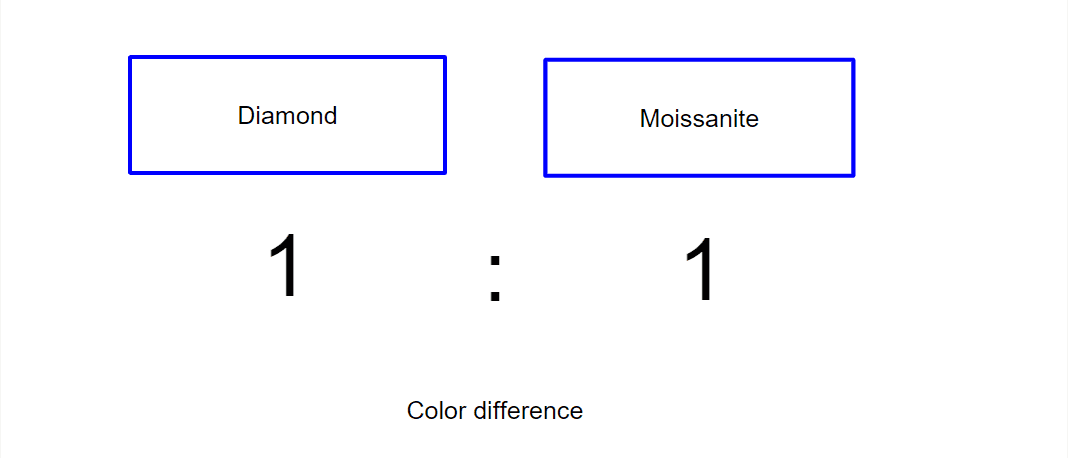
Color is another criterion that reveals such striking differences between our opponents. Let’s figure out how the tone of their appearance changes the result in the Diamonds Against Moissanite competition!
On the one hand, color is a typical element to distinguish a good diamond from all the low-quality ones. In particular, GIA classifies colorless diamonds by prescribing them different color grades in the range from D to Z. The more distant the letter from the beginning of the alphabet, the more visible the diamond's color tint. In this grading system, Z-colored diamonds have such a visible yellowish or brownish hue that it’s easy to mistake them with light-yellow colored diamonds. But this resemblance is not what you need!
The best diamonds are as pure and colorless as possible. And so, D color is what all diamond buyers aim at getting. However, you shouldn’t think of matters in extreme ways — it’s still possible to find a colorless-looking diamond among J-colored stones. Generally, diamond traders don’t deal with diamonds lower than M color — because nobody will buy them for jewelry. So, the color gradation is limited to 10 tones in practice, making it easier for you to choose.
In contrast to a diamond, moissanite doesn’t have any sophisticated color gradation. The general rule is that Forever Classic moissanite has a hue that is close to K diamond color. This gemstone has yellow or green tints that become visible on closer inspection — just like a K-colored diamond with a slightly noticeable yellowish or brownish tint. Nevertheless, both moissanite and this diamond look attractive and colorless in small size and an engagement ring.
So, the ability to get a better color grade and the special appearance of D color makes our classy female friend win this round in Diamonds vs. Moissanite race. One point goes to a diamond!
However, our descriptions of colors wouldn’t be accurate without mentioning the recent enhancements moissanite creators have introduced into the stone’s chemical composition. In particular, the brand Charles & Colvard presented several new models of moissanite with better color parameters. Its Forever Brilliant invention is already close to the G color of a natural diamond. And Forever One goes even further, looking like D, E, or F color!
Nevertheless, the color purity of moissanite is still far from perfect, and the price advantages of this gem type are not that enjoyable. In other words, even the purest moissanite doesn’t resemble the exemplary D color. That’s because the very ability of moissanite to display color is incomparable to a diamond.
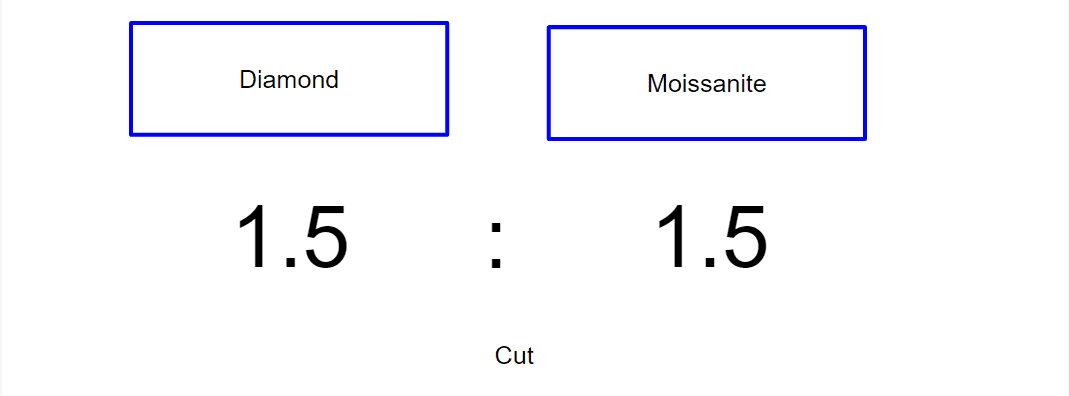
Once compared under this parameter, a diamond and moissanite are pretty similar. So, it will be hard to determine the winner of Diamonds Against Moissanite battle now. Let’s try to figure out something.
Both gemstones come in the variety of cuts, including round, oval, pear, cushion, square, princess, marquise, emerald, radiant, and Asscher forms. Moissanite even reveals itself as pretty old-fashioned here: some shapes are not used by diamond cutters already but still appear in some moissanite collections.
The similarities between a diamond and moissanite expand to the popularity of chosen cuts. Most moissanite stones and diamonds come in a round shape. In this cut, both precious stones reveal their sparkle, appear completely colorless, and fit any jewelry design perfectly.
In the given circumstances, we had nothing but to conclude a mediation agreement in Diamonds vs. Moissanite conflict and give each rival a 0.5 point.
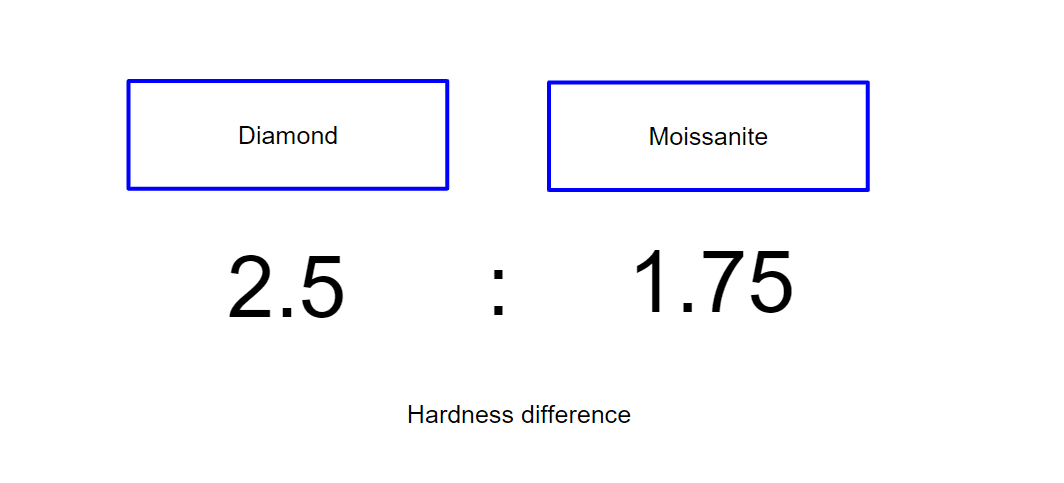
In terms of hardness, both moissanite and diamonds are unsurpassed. But in this clash of the titans, there can be only one winner. Jumping ahead, it is a diamond.
We invited the Mohs scale to judge the contestants in this round of Diamonds against Moissanite battle. Our referee is the gradation tool that determines the scratch resistance of a mineral to another one. This ordinal scale ranges all the materials from 1 to 10, where the maximum points stand for maximum hardness.
On the Mohs scale, 10 points go to a diamond. It’s four times harder than sapphire and ruby with their 9 points. In its turn, silicon carbide gets 9.25 points. This makes it harder than most precious stones — but still softer than a diamond.
Thus, in this round, 0.25 Mohs go to moissanite, and 0.75 Mohs go to a diamond. The natural mineral becomes the new leader! But let’s see what the new lap in the Diamonds against Moissanite will bring.
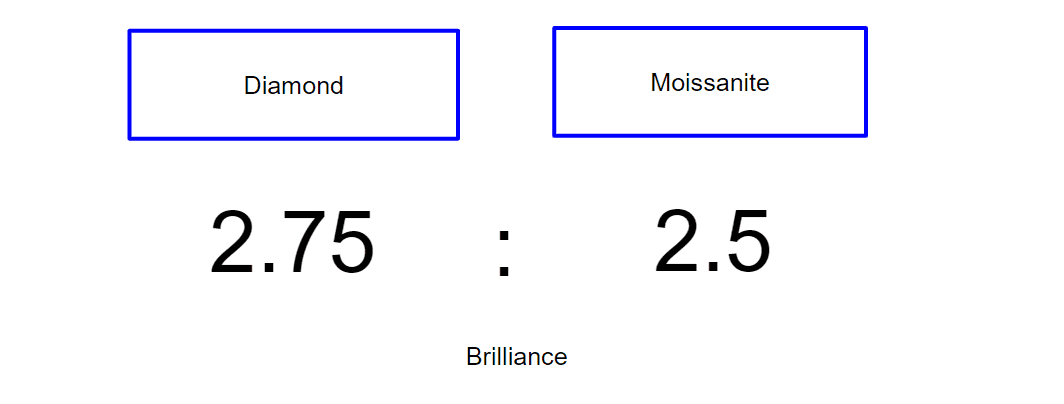
Brilliance stands for the ability of precious stones to refract light and appear sparkly. It’s one of the most determining factors to distinguish our rivals, even if you’re an inexperienced jewelry spectator. Thus, it takes one contestant in our Diamonds vs. Moissanite battle to the big leagues.
Generally, both precious stones have a very similar refractive index and appear sparkly. But here, the list of resemblances ends, and moissanite starts having eye-clean advantages.
Among all, moissanite is capable of so-called “double refraction.” It’s a visual effect that appears when you look through the top of a jewel and spot the doubled illusion of its facets on the opposite sides. This results in a vibrant sparkling of a stone. A diamond lacks this effect.
Moreover, moissanite is known for having more fire — or a rainbow-colored sparkling. Even though both precious stones showcase the significant degree of fire, moissanite demonstrates more remarkable hues in its spectrum. Hence, this jewel has greater light and color performance.
With regard to the factors mentioned above, this round in Diamonds vs. Moissanite battle sends moissanite up. Although, it’s worth to remark that diamond has a more natural “energy” in the way it disperses light. In addition, when you put diamonds against moissanite in the small sizes and look at them from a distance, you won’t see dramatic differences in their brilliance. That’s because these rules work with big jewels only.
Both jewels have remarkable brilliance, but moissanite does this better. Hence, we assign 0.25 points to a diamond and 0.75 points to moissanite.
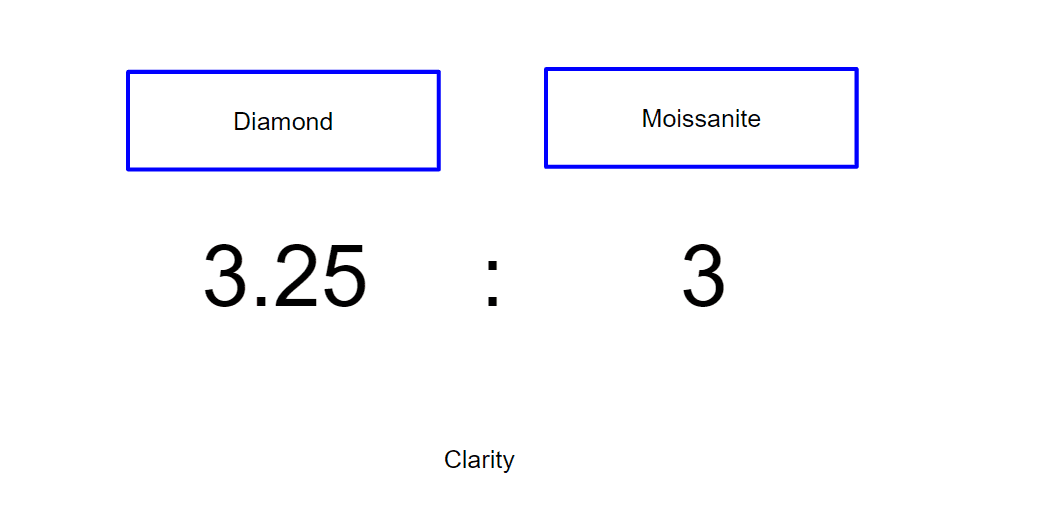
When it comes to clarity, both stones demonstrate a significant degree of imperfection. These gems are relatively equal because the exact appearance of their differences, as well as advantages, varies.
On the one hand, the objectivity of clarity prescription is questionable in the case of moissanite. In the industry, it’s standard to send diamonds to the gemological laboratory (like GIA and AGS). The reputation of these grading institutes protects diamonds with the quality mark. On the contrary, the clarity evaluation of moissanite is the responsibility of its manufacturer or seller only. It creates a conflict of interest and leaves the space for manipulations and unfair assessment from moissanite traders.
On the other hand, the control over clarity during the initial moissanite manufacturing is much better than in diamonds. The laboratory controls the appearance of stones to become close-to-flawless, while the natural environment of mining diamonds makes this parameter vary widely. Finding a good diamond may take more time — especially without help from diamond experts. At the same time, the result is always worth this effort.
Due to the parity between our rivals in the Clarity round, we assign 0.5 points to both diamonds and moissanite.
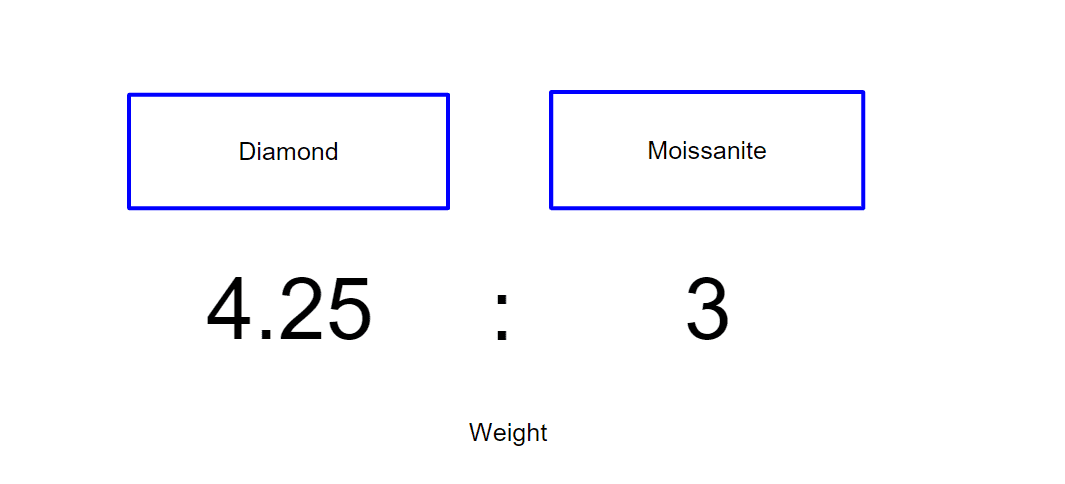
So, it’s time for the final! At last, we’ll weigh our rivals.
While discussing the prices, we’ve mentioned that the direct comparison between our two stones is relative. That’s because the size doesn’t determine the cost of diamonds — but, at the same time, this parameter is the only one available to measure moissanite. If you compare the weight of these precious stones, moissanite appears 15% lighter! For your money, you’ll inevitably get a heavier diamond, which questions the accuracy of the price-focused comparison.
This means the last round turns a diamond into a winner in the Diamonds vs. Moissanite race!
However, this doesn’t mean that the story about a diamond and moissanite is complete. In the end, your priorities will determine the result of the game. And here, we have a couple of additional comments for your consideration.
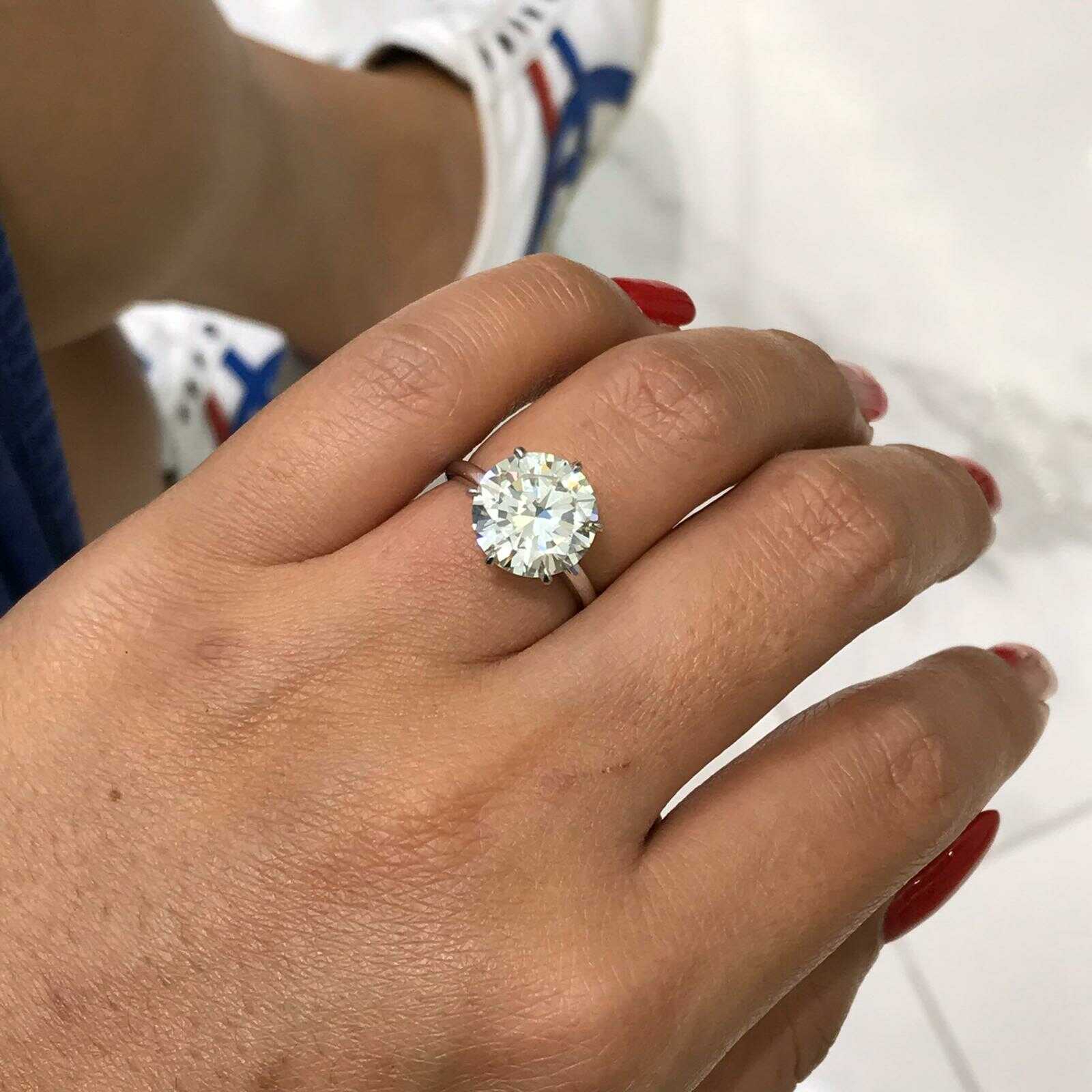
Diamond fans call moissanite a fake diamond, but this definition is not accurate. As you saw in the battle, some identical parameters of these gemstones are different and make their comparison inaccurate. The need for distinction occurred due to the popularity of both precious stones in engagement rings.
So, the answer is, “No, these stones are very different.”
If to summarize all the advantages of moissanite in 3 key points, it is:
Simply put, moissanite is a nicely-sparkling toy. Among all, its affordable price attracts customers. So, if you don’t understand diamonds’ value and consider them overpriced, moissanite is a precious stone for you. Indeed, it’s the best alternative to a diamond among various simulants — including sapphires, rubies, emeralds, and cubic zirconia. In particular, it’s cheaper and simulates the aesthetic of a diamond in the best resemblance possible.
In addition, moissanite is beneficial as an ethical jewel you can wear every day. At the same time, it may look artificial for a high-end jewelry admirer. Also, it doesn’t possess a strong cultural background to become part of an engagement ring. In the given circumstances, it’s easy to get in trouble with moissanite if your girl wants a real diamond. She can even get upset that you decided to save on her! Thus, think twice and ask her before making this choice.
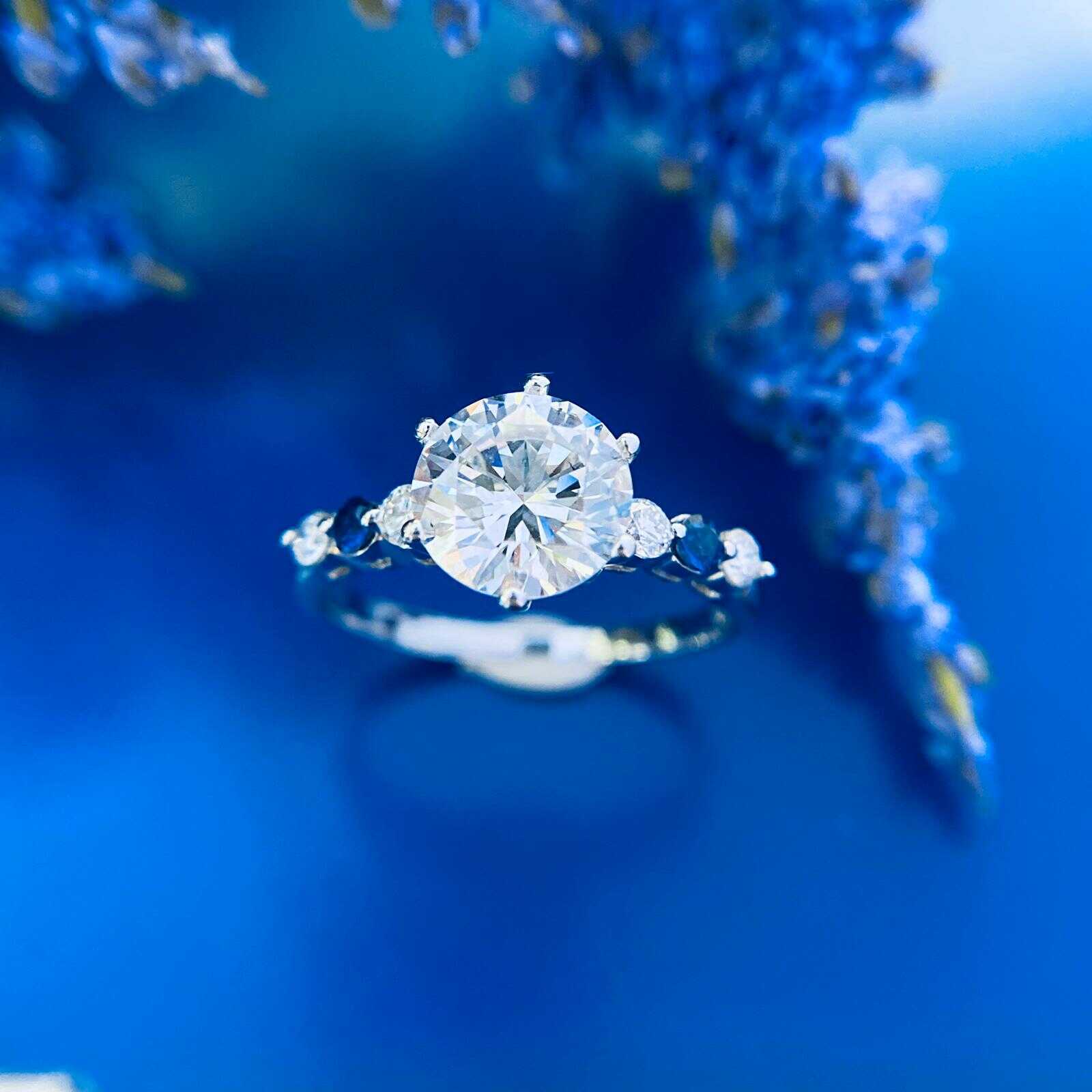
Here are 3 key advantages of a diamond. It has:
With a diamond engagement ring, you’ve done everything right. The jewel is undoubtedly valuable, having a sacred meaning and a rich story of being a symbol of love, happiness, and long-lasting relationship. With these characteristics, a diamond can mark a significant life event.
If the person you’re about to propose has real value for you, the engagement ring deserves nothing but a diamond. It costs all its money and is a valuable investment asset for the future.
However, note that the real value of diamonds against moissanite is hidden beyond their appearance. Even jewelry specialists use a “moissanite tester” to validate the stone origin by electrical conductivity testing. For couples, it’s even harder to distinguish these stones without special equipment.
Thus, you have complete freedom of choice. You can either invest more and get a diamond today or enjoy the short-term brilliance and price benefit of moissanite for your special occasion. Check the priorities and make a choice — there’s no right or wrong option here anyway.
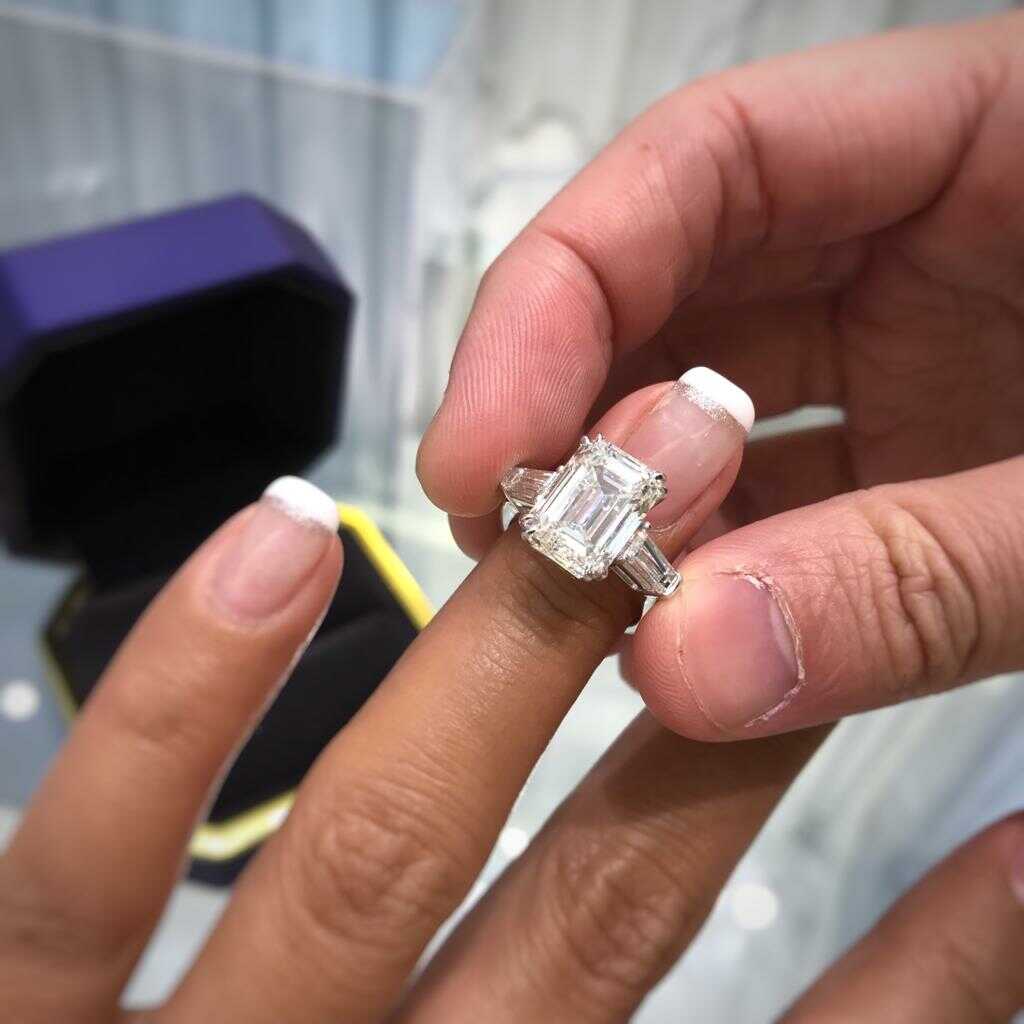
If you’ve decided to follow the winner and pick a diamond engagement ring, you’re welcome to request a consultation from Diamond Registry experts. Since 1961, we make diamonds available to the wide public for wholesale prices. Drop us a line, and we’ll get the perfect diamond ring for you!

